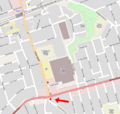World Cup Sculpture facts for kids
 |
|
| Coordinates | 51°31′48.43″N 0°2′16.5″E / 51.5301194°N 0.037917°E |
|---|---|
| Location | Near the Boleyn Ground (Upton Park), former home of West Ham United |
| Designer | Philip Jackson |
| Type | statue |
| Material | bronze sculpture |
| Height | 16 feet (4.9 m) |
| Beginning date | 2001 |
| Completion date | 2003 |
| Opening date | 28 April 2003 |
| Dedicated to | England's 1966 World Cup Final victory |
The World Cup Sculpture, also called The Champions, is a bronze statue in London, England. It stands near the old stadium of West Ham United Football Club. The statue shows a famous moment from the 1966 World Cup Final.
It features four English football heroes: Bobby Moore, Geoff Hurst, Martin Peters, and Ray Wilson. This was the only time England has won the World Cup. The statue shows England's captain, Bobby Moore, holding the Jules Rimet Trophy high. His teammates hold him on their shoulders.
Newham London Borough Council and West Ham United asked for the statue to be made. It celebrates West Ham's part in the victory. Moore, Hurst, and Peters were all West Ham players in 1966. The famous sculptor Philip Jackson created the statue. Prince Andrew unveiled it in 2003.
Contents
About the Statue
The statue is named The Champions or The World Cup Sculpture. It is made of bronze and is one and a half times bigger than real life. It stands about 16 feet (4.9 m) tall and weighs four tonnes.
You can find it at the corner of Barking Road and Green Street in London. This spot is very close to the old Boleyn Ground stadium, which was West Ham's home.
The Story Behind the Statue
The statue shows the exciting moments right after England won the 1966 World Cup. England beat West Germany 4-2 in extra time in the final. The game was played at the old Wembley Stadium in London.
In that match, Bobby Moore was the team captain and a strong defender. Ray Wilson played as a full-back. Martin Peters was in midfield, and Geoff Hurst was a striker. Hurst scored the first goal, Peters scored another, and Hurst scored two more in extra time. This gave Hurst a famous World Cup hat-trick and secured England's win.
Philip Jackson used photos taken right after the game to create the statue. One famous photo shows Bobby Moore holding the Jules Rimet World Cup Trophy above his head. Geoff Hurst and Ray Wilson are holding him up, and Martin Peters is also there. It's a moment of pure joy and victory.
Jackson did change Ray Wilson's face a little in the statue. In the real photo, Wilson looked a bit strained because he was holding a lot of Bobby Moore's weight! Jackson thought Wilson wouldn't mind this small change. Wilson later joked that he was only there to help lift Bobby.
How the Statue Was Made
Getting Started
West Ham United and the Newham London Borough Council worked together to get the statue made. At the time of the 1966 World Cup win, Bobby Moore, Geoff Hurst, and Martin Peters all played for West Ham. Ray Wilson played for Everton F.C..
A local council member, Graeme Cambage, first thought of the idea. He wanted a statue of Bobby Moore after Moore passed away. It took a long time for his dream to come true. The statue cost about £725,000 in total. Most of the money came from a government grant and West Ham United.
Building the Statue
The plan for the statue was announced in October 2001. Geoff Hurst, Martin Peters, and Ray Wilson saw a small model of the statue then. The actual statue took one year to build.
Unveiling Day
The statue was officially revealed on April 28, 2003. Prince Andrew, Duke of York, who was the president of the Football Association, did the honors. This happened on the tenth anniversary of Bobby Moore's death.
Hurst, Peters, and Wilson were there, along with Bobby Moore's wife, Stephanie. During the ceremony, Prince Andrew accidentally called Bobby Moore "Sir Bobby." This was special because many people wanted Moore to be given a special honor after his death.
Images for kids




